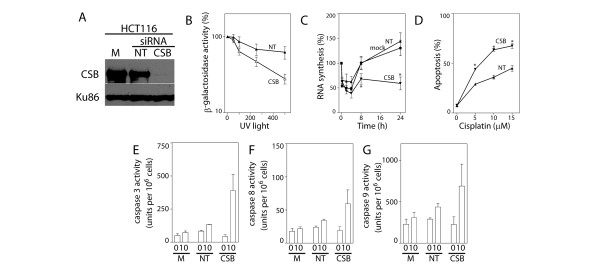Figure 2.
Silencing CSB in HCT116 cells. (A) The effectiveness of siRNAs against CSB in HCT116 cells was assessed by immunoblot analysis of nuclear lysates from cells that were either mock-transfected (M) or transfected with the indicated siRNA (non-targeting control (NT) or CSB). (B) Host cell reactivation of a UV-damaged reporter gene was assessed in non-targeting siRNA (NT) and CSB siRNA (CSB) transfected cells. Reduced CSB levels were associated with a decrease in the dose required to reduce β-galactosidase activity to 50% (P < 0.05, t-test). (C) The ability of mock-, NT- and CSB-siRNA transfected cells to recover nascent RNA synthesis following UV exposure was assessed in HCT116 cells. (D) Similarly transfected HCT116 cells were exposed to the indicated dose of cisplatin and apoptosis was assessed as the proportion of cells with subdiploid DNA content 48 hours later. (E-G) The activity of caspases 3, 8 and 9, respectively, was determined 24 hours following exposure to 10 μM cisplatin. Each value in B-G represents the mean (± SEM) determined from a minimum of 3 independent experiments. An * in C indicates that the value is significantly less than 100% (P ≤ 0.05, single sample t-test) while an * in D indicates that the value is significantly different from its respective NT control (P ≤ 0.05, t-test). There was a significant difference in caspase 3 but not caspases 8 or 9 activity among transfectants following cisplatin treatment (P = 0.04, 0.14 and 0.30, respectively, ANOVA).

